



Table of Contents
- What is a Row House?
- Types of Row Houses
- Advantages of Row houses
- Disadvantages of Row Houses
- Faq's
Rowhouses, also known as townhouses, are a popular type of residential housing arrangement that combines the benefits of individual homeownership with a sense of community living. In this article, we will explore rowhouses, their structure, advantages, and disadvantages compared to other traditional housing options.
What is a Row House?
A row house, also known as a townhouse, is a type of residential dwelling designed for a single family but shares a common wall with neighboring units. Unlike standalone homes, row houses are organized in a linear arrangement, with each unit stacked next to the other in a row. This architectural layout is ideal for urban areas or locations where space is limited. Row houses feature uniform architectural designs with aesthetically pleasing facades, yet each unit maintains its individuality within the shared structure.
There are several key characteristics commonly found in row houses:
- Each unit has its own entrance and does not share a common stairway with neighboring units.
- Row house developments typically consist of a minimum of three units aligned in a row.
- The structural design of row houses emphasizes uniformity, with consistent architectural features and fenestration patterns.
- Many row house communities implement rainwater harvesting systems to promote sustainability and environmental conservation.
- Solar-powered lighting solutions are increasingly common in row house neighborhoods, offering energy-efficient alternatives for illuminating homes and common areas.
Overall, row houses offer a harmonious blend of individual privacy and community living, making them a popular choice for urban dwellers seeking affordable and space-efficient housing options.
Types of Row Houses
Row houses come in various types, each offering unique architectural features and design elements to cater to different preferences and lifestyles. Here are some common types of row houses:
Traditional Row Houses
Traditional row houses stand as enduring symbols of urban living, steeped in history and architectural significance. Their uniform facades and shared walls tell stories of community resilience and cultural heritage, shaping the character of neighborhoods across generations. With brick or stone exteriors, symmetrical windows, and narrow footprints, these homes maximize land use while exuding timeless charm. From bustling city centers to quaint historic districts, traditional row houses offer a glimpse into the past while remaining integral to the fabric of modern urban landscapes.
In recent years, a renewed appreciation for traditional row houses has sparked revitalization efforts in many urban areas. These iconic homes have become sought-after residences, attracting residents drawn to their historic allure and central locations. Adaptive reuse projects breathe new life into aging row house neighborhoods, preserving their architectural integrity while accommodating contemporary lifestyles. As cities evolve and grow, traditional row houses continue to stand as testaments to the enduring appeal of urban living and the rich tapestry of urban history.
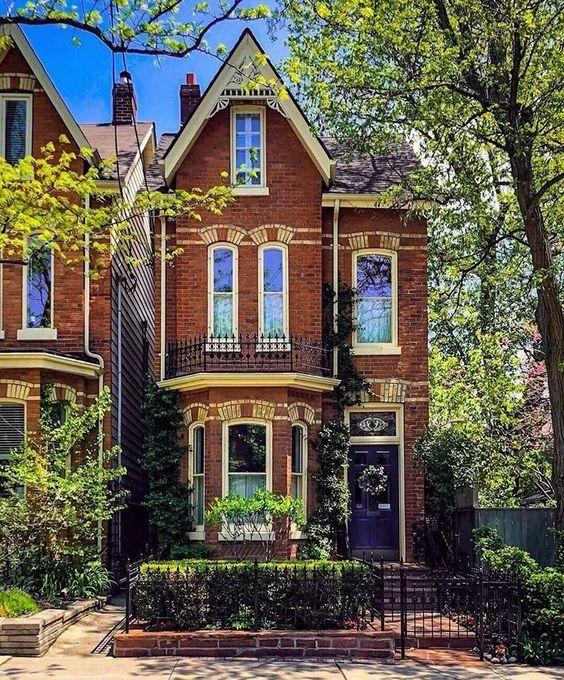
Source: Pinterest
Modern Row Houses
Modern row houses epitomises contemporary living with their sleek lines, minimalist aesthetics, and innovative architectural design. These homes depart from traditional norms, embracing cutting-edge materials like glass, steel, and concrete to create striking facades and interiors. With an emphasis on clean, geometric shapes and asymmetrical compositions, modern row houses exude a sense of sophistication and urban chic.
Open floor plans are a hallmark of modern row houses, promoting seamless flow between living spaces and fostering a sense of spaciousness. Large windows and skylights invite abundant natural light indoors, creating bright and airy environments conducive to modern living. Additionally, eco-friendly features such as solar panels, energy-efficient appliances, and sustainable building materials are often integrated into the design, reflecting a commitment to environmental sustainability and green living practices.
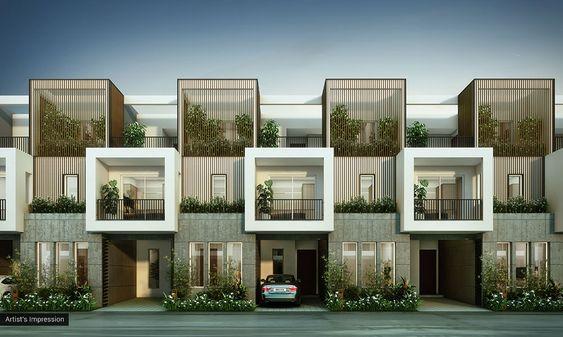
Source: Pinterest
Victorian Row Houses
Victorian row houses are characterized by ornate detailing, decorative trim, and elaborate facades inspired by Victorian-era architecture. These homes often feature intricate woodwork, colorful exteriors, and embellished facades with bay windows, turrets, and gingerbread trim. Victorian row houses are commonly found in historic neighborhoods and urban areas with rich architectural heritage.
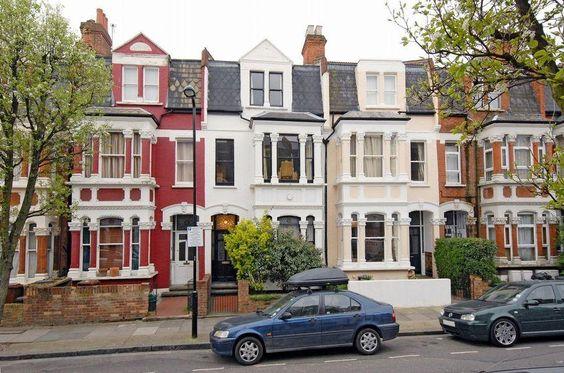
Source: Pinterest
Brownstone Row Houses
Brownstone row houses are a distinct type of townhouse commonly found in cities like New York City and Philadelphia. They are characterized by their signature brownstone facades, elegant stoops, and classic architectural details. Brownstone row houses often feature multiple floors with high ceilings, grand staircases, and spacious interiors.

Source: Pinterest
Colonial Row Houses
Colonial row houses draw inspiration from colonial architecture and design principles. These homes typically feature symmetrical facades, simple geometric shapes, and traditional building materials such as brick or clapboard siding. Colonial row houses may have central entryways, gabled roofs, and multi-pane windows, reflecting the timeless appeal of colonial-era design.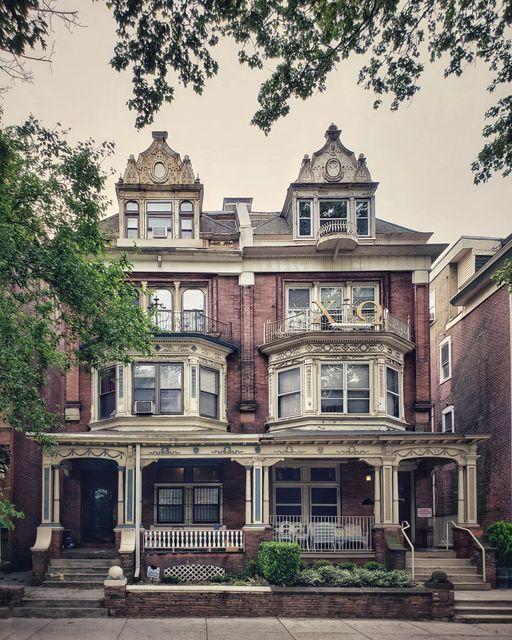
Source: Pinterest
Loft-style Row Houses
Loft-style row houses combine the industrial aesthetics of loft living with the compact footprint of traditional row houses. These homes often feature open floor plans, high ceilings, exposed brick or ductwork, and large windows to maximize natural light. Loft-style row houses are popular in urban areas with former industrial buildings being converted into residential spaces.
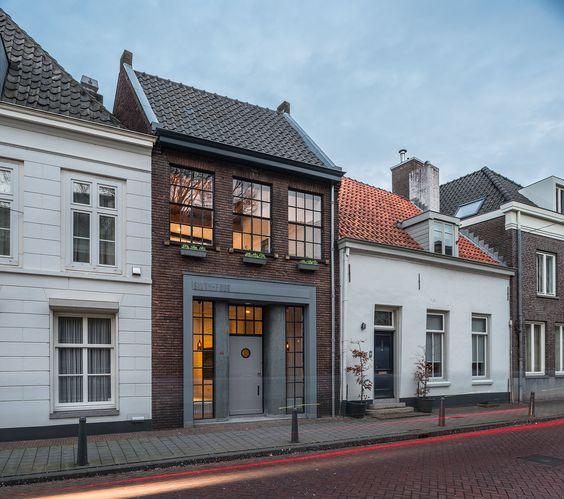
Source: Pinterest
Contemporary Row Houses
Contemporary row houses embrace modern design principles while retaining the efficient layout of traditional row houses. They may feature clean lines, geometric shapes, and innovative materials to create a sleek and stylish appearance. Contemporary row houses often prioritize functionality, sustainability, and connectivity with outdoor spaces.

Source: Pinterest
These are just a few examples of the diverse range of row house styles available, each offering its own unique charm, character, and architectural appeal.
Advantages of Row houses
Community Living
Rowhouses offer a sense of community due to their close proximity to neighbors, fostering social interactions and a shared sense of belonging.
Space Efficiency
Despite sharing walls, rowhouses provide individual living spaces with multiple floors, making them suitable for families or individuals who value privacy.
Urban Living
Common in urban settings, rowhouses offer a residential option that maximizes land use and provides a balance between city living and a sense of neighborhood. Row houses, also known as townhouses, offer several advantages that make them an appealing housing option for many individuals and families. Some of the advantages of row houses include:
Cost Effectiveness
Row houses are often more affordable than detached single-family homes, making them an attractive option for first-time homebuyers or those looking to downsize without compromising on space.
Space Efficiency
Despite being connected to neighboring units, row houses typically offer ample living space spread across multiple floors. This layout maximizes the efficient use of space while providing residents with the comfort and privacy of a standalone home.
Community Living
Row house developments often foster a strong sense of community among residents. With shared walls and common areas, neighbors have more opportunities for social interaction, collaboration, and support.
Low Maintenance
Many row house communities have homeowners associations (HOAs) responsible for maintaining common areas, landscaping, and exterior upkeep. This shared responsibility can help reduce individual maintenance tasks and associated costs for homeowners.
Security
The proximity of neighboring units in row house developments can enhance security by creating a close-knit community where residents look out for one another. Additionally, many row house communities have security measures in place, such as gated entrances or security patrols, to further ensure residents safety.
Amenities
Row house developments often include shared amenities such as parks, playgrounds, swimming pools, or fitness centers. These amenities enhance residents quality of life and provide recreational opportunities without the need for individual ownership or maintenance.
Urban Living
Row houses are commonly found in urban or suburban areas, offering residents convenient access to amenities, public transportation, schools, and employment opportunities. This urban connectivity makes row houses an attractive choice for those seeking a vibrant lifestyle with easy access to city amenities.
Architectural Variety
While row houses share a common layout and architectural style, they often feature individualised exteriors or design elements that allow homeowners to personalize their space. This architectural variety adds character and visual interest to row house communities.
Overall, row houses offer a blend of affordability, space efficiency, community living, and convenience that appeals to a wide range of homebuyers. Whether in urban or suburban settings, row houses provide residents with the comfort, security, and amenities of a standalone home within a supportive community environment.
Disadvantages of Row Houses
While row houses offer numerous advantages, they also come with some potential disadvantages that prospective buyers should consider:
Limited Privacy
Row houses share common walls with neighboring units, which can result in reduced privacy compared to detached single-family homes. Noise transmission between units may be a concern, and residents may need to be mindful of noise levels to avoid disturbances to neighboring households.
Lack of Yard Space
Row houses typically have limited outdoor space, with small front yards or no yards at all. This lack of yard space may be a drawback for homeowners who enjoy gardening, outdoor recreation, or entertaining outdoors. Residents may need to seek alternative outdoor spaces such as parks or community gardens.
Shared Maintenance Costs
While shared maintenance can be a benefit in terms of reducing individual responsibilities, it also means that homeowners are financially responsible for common area maintenance and repairs. Homeowners' association fees or maintenance assessments may increase over time, impacting the overall cost of homeownership.
Architectural Uniformity
Row houses often feature uniform architectural designs and facades, which may limit individuality and personal expression in home aesthetics. Homeowners may have limited options for exterior modifications or renovations, leading to a lack of architectural diversity within the community.
Parking Challenges
Row house communities may face challenges related to parking availability and congestion, especially in densely populated urban areas. Limited on-street parking or shared parking lots may result in competition for parking spaces among residents and guests, leading to inconvenience and frustration.
Potential for Conflict
Living in close proximity to neighbors in row houses can sometimes lead to conflicts over issues such as noise, property boundaries, or shared amenities. Differences in lifestyle preferences or living habits may result in tension or disputes between neighboring households, impacting the overall quality of life within the community.
Resale Limitations
Row houses may have limitations on resale value or marketability compared to detached single-family homes. Factors such as limited outdoor space, architectural uniformity, and shared maintenance responsibilities may affect the desirability of row houses among potential buyers, potentially impacting resale opportunities.
Vulnerability to Natural Disasters
Row houses, particularly those located in densely populated urban areas, may be more susceptible to damage from natural disasters such as earthquakes, floods, or hurricanes due to their shared walls and compact construction. Homeowners may need to invest in additional measures to mitigate risks and ensure structural resilience.
In conclusion, row houses, also known as townhouses, offer a unique blend of individual homeownership and community living, making them a popular choice for urban and suburban dwellers alike. With their space-efficient design, affordability, and shared amenities, row houses provide residents with the comfort, convenience, and sense of belonging that many seek in a home.
However, it is important to consider the potential drawbacks, such as limited privacy, shared maintenance costs, and architectural uniformity, before committing to row house living. By weighing the advantages and disadvantages, prospective buyers can make informed decisions that align with their lifestyle preferences and financial considerations. Ultimately, whether in traditional or modern row house developments, these iconic homes continue to play a significant role in shaping the fabric of urban neighborhoods and communities.
explore further
Latest from Home Buying Tips
More from Recommendations
Resources
Dwello, for every home buyer, is a way to go from 'I feel' to 'I know', at no extra cost.




